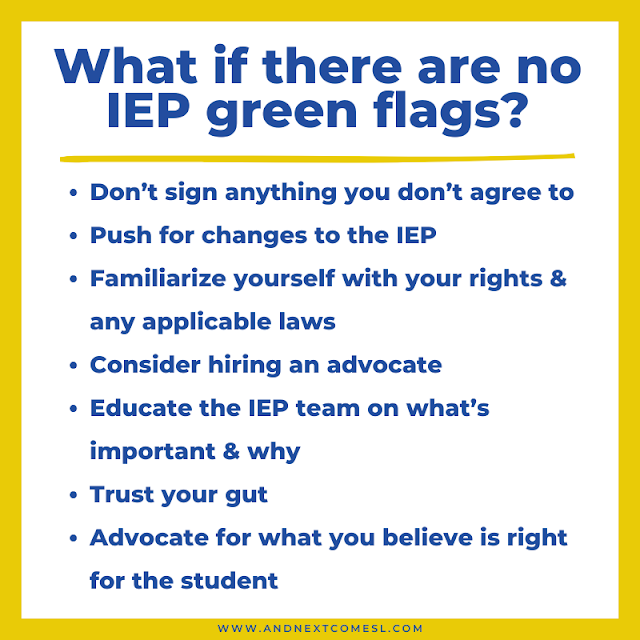IEPs don't have to be stressful or negative experiences, but often that is the reality...
Sometimes IEPs are rushed, have inappropriate goals and accommodations, and are anything but student centered.
Maybe you've noticed one red flag after another and it makes you extremely nauseous and uncomfortable.
But how do you know what to look for in a good IEP? Or what a productive and healthy IEP meeting looks like?
Surely, there have to be some positive signals that you can look for. Well, there are!
Below you'll find a list of IEP green flags. Things you want to see during the IEP process that can lead to more productive and healthy meetings and better IEPs for students. But first, a definition...
IEP Green Flags Meaning
You're probably familiar with the idea of red flags, right? Red flags refer to the negative things that you want to watch out for and avoid at all costs. In other words, they are the warning signs.
Green flags, on the other hand, are the opposite. They are the positive signals. The good things. The things you want to see. They are a sign that things are healthy and productive.
So, in this particular context, IEP green flags are the positive signals and good things that you want to see in an IEP.
IEP Green Flags: What to Look for
Now there are lots of different green flags to look for in an IEP document and during an IEP meeting. Keep in mind that you might see only some of these signs, all of them, some variation of the following, more subtle forms of the green flags, or sometimes, sadly, none of them at all (obviously we don't want that!).
Here are some green flags that you might notice during the IEP process:
- It is student centered and individualized
- Neurodiversity-affirming and strengths-based language is used in place of deficit language
- Collaborative team approach
- Parental concerns are considered and addressed
- Values and seeks out input from parents, the student, and other support services
- The goals and objectives are tailored to the student and their unique needs
- The goals are specific, clear, and measurable
- The student's strengths and abilities are recognized and discussed
- Accommodations, supports, and IEP services are appropriate and align with the needs of the student
- Data is shared with all members of the team, including parents (this includes providing copies of written plans, reports, goals, evaluations, etc. when requested)
- The student's special interests are considered and incorporated into the plan, if possible
- Communication remains open, transparent, and respectful, even when there are disagreements
- Adequate time is given for the IEP meeting (i.e., it isn't rushed or cut short and all members are there for the entire duration)
- Parents are allowed to take time to review the IEP before signing it (i.e., they can take the document home, read it over, and aren't pressured to sign it during the meeting itself)
- The student has access to a supportive and inclusive learning environment
- IEP team members presume competence
Obviously, there can be other signs, but you can see how this list focuses on using a collaborative approach to understand and support the individual.
IEP Green Flags: Examples
It is worth noting, though, that sometimes the green flags might be subtle and hard to spot. Like how do you know if a goal is clear and measurable? How do you know if data is being shared with all members of the team? How do you know if your parental concerns are being adequately addressed?
Well, let's take a closer look at some specific examples of what a green flag in an IEP might look like. Keep in mind that the green flags might show up in the smaller, more minute details. So, for example:
- The student is referred to by their name and the document doesn't appear to be just a copy and paste of someone else's plan (so be sure to check that it has the correct grade, teacher, diagnoses, etc.)
- All important and relevant labels are considered (i.e., they don't just focus on the fact that a child is autistic, but also recognize their hyperlexia as well, for instance)
- You see positive and identity-first language such as autistic person (vs. student with autism spectrum disorder) and/or neurodiversity-affirming phrases such as "benefits from" (vs. struggles with)
- Multiple team members are present during the IEP meeting and are CC'ed on relevant emails
- The team members actively listen to parents, answer their questions, ask them for their input, and take their feedback and concerns into consideration
- IEP goals are rewritten after a team member or parent raises a concern instead of it being brushed off as a "we've always done it this way" kind of attitude
- Strategies and accommodations seem to be tailored to the needs of the student and incorporate the student's interests
- The student's strengths are discussed and outlined explicitly and are accurate (refer back to the first bullet point about copy and paste IEPs)
- A signature isn't requested until all requested changes have been made
- The team is open to exploring new ideas (e.g., "I'll look into that!" or "Let's see what we can do.") instead of shutting down different options (e.g., "We don't do that here" or "That option isn't available")
- The team addresses the parent by their name (trust me, being called "Mom" instead of Dyan during a meeting is so degrading and disrespectful)
You can see how subtle some of these are.
So, take notice of who is or isn't in attendance at the IEP, how others on the team refer to the parent or the student, and the wording of things. All of those little details can be important green flags and make a huge difference in the IEP writing process.
What if There are No Green Flags?
Remember, you don't have to sign anything you don't agree to. So, if all you see are inappropriate goals, mistakes, negative language, and/or any other red flags, then keep pushing for changes to the IEP.
It's also important to educate yourself, specifically about what the laws are and what your rights are for where you live. Every school division/district, country, province/state, etc. will have different rules and laws that pertain to education, disability, students' rights, and so forth. You should try to be familiar with what these rights and laws are.
Parents can also educate the IEP team members on what values are important and why. For example, explain why neurodiversity-affirming language, a strengths-based approach, and individualized supports are important to you.
You can also consider hiring an advocate to speak on your behalf and/or join you at IEP meetings.
Finally, trust your gut. If something seems off or makes you uncomfortable, don't settle. Be firm and advocate for what you believe is right for the student.
A Quick Recap of IEP Green Flags
IEPs can often be a stressful and negative experience for parents, but they don't have to be. Here's a quick recap of what was discussed above:
- There can be lots of red flags to watch out for during the IEP process, but there can also be a lot of green flags or positive signals to look for. Obviously, you want to make sure you see more green flags than red flags.
- IEPs should be student centered, individualized, collaborative, and tailored to the individual student.
- A team approach should be taken when it comes to IEPs. That means seeking input from all team members, sharing data amongst the entire team, and communicating openly and respectfully.
- You might not notice many green flags or any at all. Or, sometimes, they might be subtle. Sometimes it's the little details that are the biggest green flags.
- Remember to familiarize yourself with laws, educate those around you, stick to your values, hire an advocate, and always trust your gut when it comes to IEPs.
- Don't sign anything you don't agree with, especially if there are a lot of red flags.
Now hopefully you'll be better equipped to notice some of these IEP green flags in your future IEP meetings and documents. And here's hoping that those green flags always outnumber the red ones.








